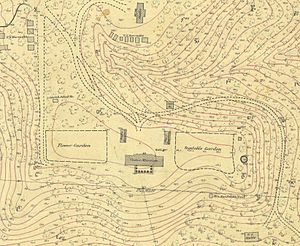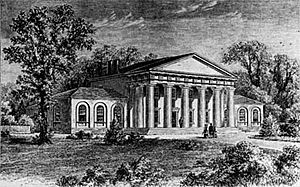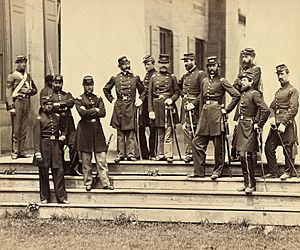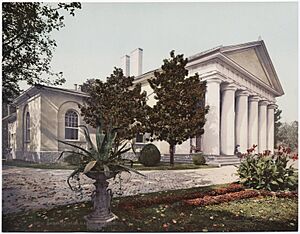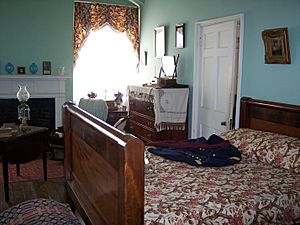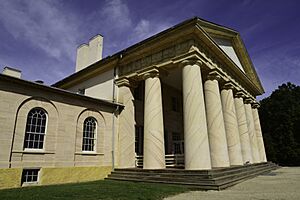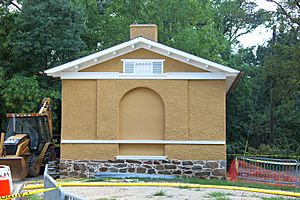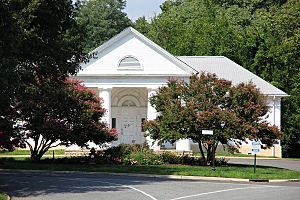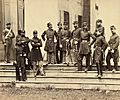Arlington House, The Robert E. Lee Memorial facts for kids
|
Arlington House, The Robert E. Lee Memorial
|
|
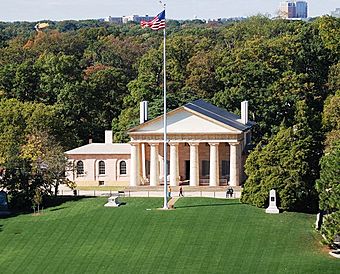
Arlington House at Arlington National Cemetery
|
|
| Location | Arlington County, Virginia, U.S. |
|---|---|
| Area | 28.08 acres (11.36 ha) |
| Built | 1803–1818 |
| Architect | George Hadfield |
| Architectural style | Greek Revival |
| Visitation | 576,816 (2011) |
| Website | Arlington House, The Robert E. Lee Memorial |
| NRHP reference No. | 66000040 |
Quick facts for kids Significant dates |
|
| Added to NRHP | October 15, 1966 |
| Boundary increase | March 17, 2014 |
Arlington House is a famous historic home in Arlington County, Virginia. It was built between 1803 and 1818 by George Washington Parke Custis. He wanted it to be a special memorial to his step-grandfather, George Washington.
Today, the National Park Service takes care of Arlington House. It sits inside the Arlington National Cemetery, which is a military cemetery. The house is built in the Greek Revival style, which looks like ancient Greek temples.
George Washington Parke Custis lived here with his family. His daughter, Mary Anna Randolph Custis, married Robert E. Lee, who later became a famous general. They lived in Arlington House for many years, and most of their children were born there.
During the American Civil War, the U.S. Army took over Arlington House. They started burying soldiers on the property, which eventually became Arlington National Cemetery. After the war, the land was returned to the Lee family, but they sold it back to the U.S. government.
Arlington House is now a national memorial. It helps us remember important parts of American history, including the lives of the Custis and Lee families, and the story of the Civil War.
Contents
Building Arlington House: A Memorial to Washington
The idea for Arlington House came from George Washington Parke Custis. He was the grandson of Martha Washington and the step-grandson of George Washington. He grew up at George Washington's home, Mount Vernon.
Custis inherited a large piece of land in 1802. He decided to build his home on a high spot overlooking the Potomac River and the growing city of Washington, D.C. He named his estate "Arlington" after his family's older home.
He hired an English architect named George Hadfield. Hadfield designed the mansion in the Greek Revival style. Custis wanted the house to be a "living memorial" to George Washington. He planned to display many of Washington's belongings there.
Construction started in 1803. It was interrupted by the War of 1812, when British soldiers burned parts of Washington, D.C. The outside of the mansion was finished in 1818. The house has a grand front with eight huge columns, each about 5 feet wide.
Life at Arlington House
George Washington Parke Custis married Mary Lee Fitzhugh. Their only child to live to adulthood was Mary Anna Randolph Custis. She married her childhood friend and distant cousin, Robert E. Lee, in 1831 at Arlington House.
For 30 years, Arlington House was home to the Lees. Robert E. Lee was a soldier, so he traveled a lot. But Arlington House was where his family lived. Six of their seven children were born there. The family also developed beautiful gardens and a wooded area called "the Grove" on the estate.
When George Washington Parke Custis passed away in 1857, he left Arlington Estate to his daughter, Mary Anna Randolph Custis Lee, for her lifetime. After her, it would go to her oldest son, George Washington Custis Lee. Robert E. Lee took a break from the Army to help manage and improve the estate.
Arlington House During the Civil War
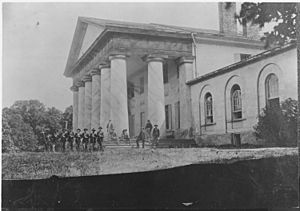
In April 1861, Virginia decided to leave the United States. Robert E. Lee, even though he was offered command of the U.S. Army, resigned and joined the Confederate States Army.
Arlington House was on high ground, looking right over Washington, D.C. The U.S. government knew it needed to control this spot. Mary Custis Lee believed the Union Army would soon take over her home. She left in May 1861. On May 24, 1861, Union Army troops moved in and occupied Arlington House without a fight.
Later, a law was passed that required property taxes to be paid in person in areas that had left the U.S. Mary Lee was ill and behind Confederate lines, so she could not pay in person. Because of this, the Arlington estate was taken by the government. It was sold in 1864, and the U.S. government bought it.
During the war, the Union Army started using parts of the estate as a cemetery. By 1864, military cemeteries were full. A general named Montgomery C. Meigs suggested using 200 acres of the Arlington Estate for burials. He even ordered burials to happen close to Arlington House. This was partly to make it difficult for the Lee family to live there again.
In 1866, the remains of 2,111 soldiers from both sides of the war were buried together near the mansion. This became the Civil War Unknowns Monument.
After the War: A New Purpose
Robert E. Lee never returned to Arlington House after the war. He passed away in 1870. Mary Lee visited the house one last time in 1873, but she was too sad about its condition to even go inside.
In 1874, George Washington Custis Lee, the eldest son of Robert E. Lee and Mary, sued the U.S. government. He wanted the property back. In 1882, the Supreme Court of the United States agreed with him. They said the government had taken the estate illegally.
However, Custis Lee decided to sell the property back to the U.S. government for $150,000. This way, the graves of the soldiers would not be disturbed.
In 1925, the U.S. Congress decided to restore Arlington House. The United States Department of the Army still manages much of the original land as Arlington National Cemetery. Over the years, the house has been furnished to show what it looked like when the Lee family lived there. In 1972, it was officially named "Arlington House, The Robert E. Lee Memorial."
The Gray Family's Important Role
One important part of Arlington House's history involves the Gray family. Selina Norris Gray was an enslaved person at Arlington House. In 1831, she married Thornton Gray, and they had eight children.
When the Civil War began, the Lee family had to leave their home quickly. Mrs. Lee gave Selina the house keys and asked her to protect the valuable items inside. Many of these items were family treasures that had belonged to George and Martha Washington.
After Union troops occupied the house, Selina noticed that some precious items were missing. She told the Union General, Irvin McDowell, about the thefts. She convinced him that the items were very important. General McDowell then helped secure the house and sent the remaining treasures to a safe place in Washington, D.C. Selina is remembered for saving these important historical objects.
Years later, in the 1920s, when Arlington House was being restored, four of Selina and Thornton's daughters helped. They shared important details about how the house looked and was furnished. Their memories helped make the restoration accurate.
Caring for Arlington House Today
From 2003 to 2007, archaeologists studied the old slave quarters at Arlington House. Their findings helped us learn more about the lives of the enslaved people who lived and worked there.
Arlington House also underwent a big renovation from 2007 to 2013. This was the first major update since 1925. The house was closed for a time, and its furniture was put on display elsewhere. After the renovation, everything was returned, and the house was rededicated.
In 2011, an earthquake in Virginia caused some damage to Arlington House. Later, in 2014, a generous donation of $12.5 million helped fix the earthquake damage and restore the mansion, its buildings, and grounds to how they looked in 1860. This project included repairing the foundation, adding new lighting, and a modern climate control system.
Other Arlington House Buildings
You can find other buildings that look like Arlington House. In Dallas, Texas, there's a building called Arlington Hall that is two-thirds the size of the original. Also, the Old Administration Building at Arlington National Cemetery, which is not far from Arlington House, has a similar front design.
Images for kids
-
Arlington House at Arlington National Cemetery
-
East front of Arlington House with Union Army soldiers on the lawn on June 28, 1864
-
The restored second-floor chamber shared by Lee and his wife, featuring a replica pattern of a 1858 U.S. Army colonel of cavalry uniform across the bed in 2005
-
The back of Arlington House at Arlington National Cemetery on Memorial Day 2017





